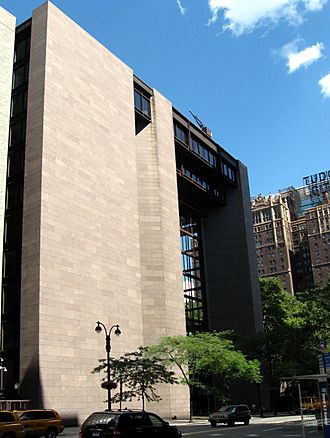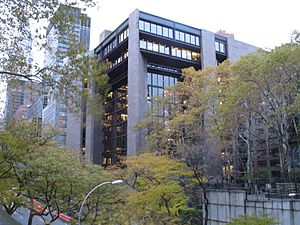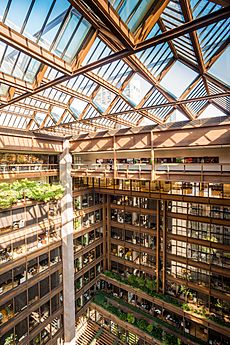Ford Foundation Building facts for kids
Quick facts for kids Ford Foundation Building |
|
|---|---|

42nd Street facade
|
|
| General information | |
| Architectural style | Late Modernism |
| Address | 320 East 43rd Street, New York City |
| Country | United States |
| Coordinates | 40°44′59″N 73°58′16″W / 40.74972°N 73.97111°W |
| Construction started | 1963 |
| Completed | 1967 |
| Inaugurated | December 8, 1967 |
| Renovated | 2016–2018 |
| Cost | $16 million |
| Client | Ford Foundation |
| Height | 174 feet (53 m) |
| Technical details | |
| Structural system | concrete and steel frame |
| Floor count | 12 |
| Design and construction | |
| Architect | Kevin Roche |
| Architecture firm | Roche Dinkeloo |
| Structural engineer | John Dinkeloo |
| Main contractor | Turner Construction |
| Awards and prizes | Albert S. Bard Civic Award Twenty-five Year Award |
| References | |
| Designated: | October 21, 1997 |
| Reference #: | 1969, 1970 |
The Ford Foundation Building (also known as 321 East 42nd Street, 320 East 43rd Street, or the Ford Foundation Center for Social Justice) is a 12-story office building in East Midtown Manhattan in New York City. Designed by architect Kevin Roche and engineering partner John Dinkeloo in the late modernist style, the building was one of the first that Roche-Dinkeloo produced after they became heads of Eero Saarinen's firm.
The building consists of a glass-and-steel cube held up by piers made of concrete and clad with Dakota granite. The main entrance is set along 43rd Street. A second entrance on 42nd Street leads to a large public atrium, the first such atrium in an office building in Manhattan. The atrium contains landscaping from Dan Kiley and includes plants, shrubs, trees, and vines. Most offices in the building are north and west of the atrium and are visible from other offices in the building.
The building was commissioned for the Ford Foundation, then the largest private foundation in the United States, after Henry Heald became foundation president. The Ford Foundation Building was announced in 1963 and completed in 1968 on the former site of the Hospital for the Ruptured and Crippled. Between 2015 and 2018, the Ford Foundation Building underwent a major renovation and restoration project. The Ford Foundation Building has been critically acclaimed for its design, both after its completion and after the renovation. The building and its atrium were made New York City designated landmarks in 1997.
Contents
Site
The Ford Foundation Building is situated on the south side of 43rd Street, in the middle of the block between First Avenue to the east and Second Avenue to the west. It has addresses at 321 East 42nd Street to the south and 320 East 43rd Street to the north, although the 43rd Street entrance is the main entrance. The site measures 202 by 200 feet (62 by 61 m), of which the building occupies an area measuring 180 by 174 feet (55 by 53 m). The Hospital for Ruptured and Crippled Children (now the Hospital for Special Surgery) previously occupied the plot.
The building is less than one block west of the headquarters of the United Nations, and surrounded by the Tudor City development. The Daily News Building is diagonally across 42nd Street and Second Avenue to the southwest.
43rd Street is a one-way street sloping down from Tudor City to the rest of the Manhattan grid. Because of the street grid of the area, vehicles traveling to the building must travel eastward on 41st Street from Second Avenue, then turn onto Tudor City Plaza (which crosses 42nd Street), and then turn again onto 43rd Street. This creates a "scenic" approach for the main entrance. One architectural critic said that the complicated approach path was "not an accident but conscious contrivance". Kevin Roche, one of the architects, stated that the approach to the building was intended to be similar to that in a rural setting.
Design
The Ford Foundation Building is 12 stories high and reaches 174 feet (53 m). It was designed by Eero Saarinen Associates (renamed Roche-Dinkeloo in 1966), composed of Kevin Roche and John Dinkeloo, who took over the firm after its namesake Eero Saarinen died in 1961. Roche was involved primarily in design, while Dinkeloo oversaw the construction. Turner Construction was the contractor for the building. The design was intended to highlight the Ford Foundation Building as the eastern terminus of the succession of commercial structures along 42nd Street's northern sidewalk.
Form
The building is located about 10 feet (3.0 m) behind the lot line. Its 12-story height was chosen because that was the same elevation as the second-lowest setback on the adjacent office tower on 42nd Street. Roche stated that the building could have been built up to 2+1⁄2 times its ultimate size, and thus have more office space that could be rented. However, the Ford Foundation—for which Roche Dinkeloo was designing the building—wanted it to be at a relatively low height as "a public gesture". Due to the area's topography, the 42nd Street entrance leads directly to the first floor, while the 43rd Street entrance is at a higher level and leads to the second floor. The spaces between the lot lines and the facades on 42nd and 43rd streets contain red-brown brick pavers.
Facade
The facade includes concrete piers and walls clad with gray-pink or mahogany South Dakota granite. A significant portion of the facade is a glass wall with weathering steel, and over 60,000 panes were used in the construction. These materials were said to "harmonize" with Tudor City's red-brick facades; although Roche criticized Tudor City as "a phony piece of stage-set architecture", he still perceived the setting as containing "a fairly nice character". The weathering steel was used because exposed structural steel was not allowed per the city's fire-safety codes at the time. The building contained three large diagonal granite piers, oriented northwest–southeast at a 45-degree angle to the street; Roche said these piers were intended to give visitors the impression that they were "partially in the building" even before entering. The design differentiated between spanning and supporting materials, employing reinforced concrete for supporting structures or simple mass, and using steel for sections of the building that overhung other spaces.
The southern elevation is on 42nd Street. The western part of this facade is a windowless granite slab. The eastern portion consists of two large granite piers: one at the center of the facade, and one at the southeastern corner. On the eastern section of the facade, the first through tenth stories have a recessed glass wall, while the eleventh and twelfth stories are recessed at a lesser depth and are carried over this recess by a glass-walled enclosure with an I-beam on top. The twelfth story protrudes further out than the eleventh story, and a catwalk hangs underneath the eleventh story. A revolving door is between the two diagonal piers, and there is an additional set of doors in the space between the center pier and the western section of the facade.
The eastern elevation faces Tudor City. It is similar to the 42nd Street elevation: the northern section is clad with granite while the southern section is a recessed glass wall, and there is a diagonally-oriented pier in the center of the facade. The southeast-corner pier does not face onto the eastern elevation. The eleventh and twelfth floors, as well as the catwalk, are also recessed to a lesser extent than the first through tenth floors.
The northern elevation is on 43rd Street. The easternmost part of the facade is a windowless granite slab. The rest of the facade is composed of glass-walled offices between four narrow granite piers that divide the windows into three vertical bays. The second-floor entrance is recessed significantly inward, creating a brick-paved porte-cochère behind the four piers. There are two brass double doors at this entrance. The third and fourth stories are recessed as well, but at a progressively smaller scale, and the eleventh and twelfth stories are also slightly recessed.
The western elevation faces a private driveway. It is faced with granite, with a narrow bay of windows and two wider window bays from north to south. This private driveway also has brick pavers, a loading dock, and garage and service entrances.
Features
Atrium
The Ford Foundation Building includes a 1⁄3-acre (0.13 ha) public atrium with a ceiling 160 feet (49 m) high. The garden inside the atrium was designed by Dan Kiley, one of Saarinen's frequent collaborators. The garden contains a series of tiers sloping up from 42nd to 43rd Street, with an elevation change of 13 feet (4.0 m). As originally arranged, the atrium had 18 aquatic plants in a pool, 37 trees, 148 vines, 999 shrubs, and 22,000 ground cover plants. Kiley transported some eucalyptus plants from California in the ultimately unrealized expectation that they would grow to 80 feet (24 m). The plantings were arranged around a centrally located square fountain.
Because of the concentration of skyscrapers in the surrounding area, artificial light was used to illuminate the garden. The atrium was originally lit by 76 spotlights on the eleventh floor and 43 lights at ground level, although these lights were subsequently replaced. Several Dakota granite piers support a glass roof above the atrium, and the paths are made of red-brown brick pavers. A glass roof composed of greenhouse-like "sawtooth" panels is located above the atrium.
The design emphasized the difference between the lobby and its atrium. The lobby is more easily accessed from 43rd Street and contains the elevator lobbies, located near the northwest corner of the building. The atrium, conversely, is more easily accessible from 42nd Street. On the western side of the atrium is a stair connecting the lobby and atrium. There are also several smaller stairs, sloped paths, and a wheelchair lift that connect the different tiers of the garden.
The public atrium contrasted with contemporary International Style structures, which had plazas outside their respective buildings. The greenery was evocative of the small park within Tudor City to the east. Roche stated in 1963 that an indoor garden had not been constructed in a contemporary building, but when interviewed later, stated that such gardens had become more common. The atrium remains publicly accessible, in contrast to other public spaces in buildings around the city, which were closed off after the September 11 attacks in Lower Manhattan in 2001.
Other interior spaces
The interiors were designed by Warren Platner. Almost every decorative metal piece in the building was made of brass to give the impression that it was gold. Wool rugs were set into the oak flooring, and furniture with leather and mahogany was used.
Most of the building's stories were designed with usable space only on the north and west sides of the building. The northern portions of the fourth through sixth stories are slightly set back behind the floors underneath them, creating three terraces that face the atrium. Planters were placed atop the terraces. The spaces were designed specifically to have offices facing either the atrium or outside onto 43rd Street. Roche said that "It will be possible in this building to look across the court and see your fellow man [...] There will be a total awareness of the foundation’s activities." The offices and hallways facing the atrium had sliding doors. Weathering steel is used to frame the glass walls overlooking the atrium, and I-beams supported each floor.
The eleventh and twelfth floors have usable space on all four sides of the building, with an open plan on all four sides. At the centers of these floors are square openings overlooking the atrium. The eleventh and twelfth floors overhang the lower floors as well as the atrium. As originally designed, the eleventh floor had a 130-foot-long (40 m) balcony overhanging the atrium, which led to a reception room with mahogany panels on the walls that hid filing cabinets. The chief executive's suite was 895 square feet (83.1 m2), containing a pantry and restroom. Another door led to a conference room that could seat 40 persons around a 12-foot-long (3.7 m) table with a leather surface.
According to blueprints, the elevators and one set of emergency stairs are located on the western side of the building, near the northwest corner. Another set of emergency stairs are located on the northeast corner. There are also emergency stairs within the diagonal piers on the eastern and southern sides of the building, at the ends of the northern and western wings respectively. In addition, there is an auditorium and conference room in the basement. This auditorium contains a tapestry by Sheila Hicks. There are 54,000 square feet (5,000 m2) of event space that can be rented for events, as well as an art gallery and office space that can be rented to other organizations.
History
Planning and construction
The Ford Foundation was established in Michigan in 1936 as a foundation for the family of Henry Ford, who had founded the Ford Motor Company. In 1949, after a report by Horace Rowan Gaither, the foundation was reorganized to focus on economic improvements, education, freedom and democracy, human behavior, and world peace. By 1950, it was the largest private foundation in the United States, and its assets were valued at about $474 million. The foundation had its main offices in Pasadena, California, and satellite offices in Detroit and New York City. The New York office was located at 477 Madison Avenue, where the foundation leased nine floors. In 1953, the New York location became the main office when the Pasadena office closed, and the foundation leased three more floors at 477 Madison Avenue the next year. The foundation's activities were changed in 1962 to focus on education, public, economic, and international affairs, as well as the arts and sciences.
In 1963, the foundation bought land facing 42nd and 43rd streets for its headquarters. At the time, it was relatively rare for private foundations to construct headquarters that were highly publicized. However, the foundation's president at the time, Henry Townley Heald, had previously headed the Illinois Institute of Technology, where he had overseen the construction of a new campus. Final plans for the Ford Foundation Building were announced in September 1964. The building was to cost $10 million and would be designed by Joseph N. Lacy, John Dinkeloo, and Kevin Roche of Eero Saarinen Associates. At the time, construction was to begin the next month and be finished in 1966. During construction, in April 1967, a construction crane fell onto 42nd Street and injured four people. The building opened on December 8, 1967. It had cost about $16 million to erect.
Usage
Due to the design of the building's glass walls, it was difficult for window washers to clean the structure, as they could only access the facade from the ground. As such, only the windows on the lowest two floors could initially be cleaned. The New York State Board of Standards and Appeals, which oversaw window-washing operations for the state's buildings, refused to approve a plan for the Ford Foundation Building's windows to be cleaned, so the windows gathered dust for the first two years after the building's completion. After the Foundation modified the location of the window-washing terminals for safety reasons, the Board approved a window-washing plan in 1969.
The Ford Foundation Building was intended to provide offices for 600 workers. In 1975, during the ongoing recession, the Ford Foundation announced that it would lay off half its employees due to portfolio losses, and would consider renting out office space in the building. The foundation's grants decreased significantly during the recession, from $197 million in 1973 to $75.8 million in 1979, though it still remained the largest private foundation in the U.S. When Franklin A. Thomas became CEO of the foundation in 1979, several rumors about his office at the building circulated, including that he had installed planters at the windows outside his office, or that he had requested all 10th floor offices except his own to be vacated.
In 2015, the Ford Foundation announced that the building would be renovated as part of a $190 million project. The city government had found the structure to be in violation of several building codes, and the building would become environmentally friendly and compliant with the Americans with Disabilities Act of 1990. Because the building was an official city landmark, the New York City Landmarks Preservation Commission had to approve the plans, and did so in April 2016. During the renovation, the foundation moved to temporary offices nearby. Darren Walker, president of the Ford Foundation, wanted as many of the elements of the original structure to be preserved as possible, though the presidential suite would be removed to create a less imposing environment. The renovation also added some event space. The architecture firm Gensler completed the project in late 2018 at an ultimate cost of $205 million. After the renovation was finished, the building became known as the Ford Foundation Center for Social Justice, reflecting the fact that the renovation had added space for social-justice groups.
Images for kids
See also
 In Spanish: Ford Foundation Building para niños
In Spanish: Ford Foundation Building para niños





